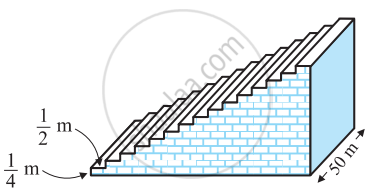Advertisements
Advertisements
Question
A small terrace at a football field comprises 15 steps, each of which is 50 m long and built of solid concrete. Each step has a rise of `1/4` m and a tread of `1/2` m (See figure). Calculate the total volume of concrete required to build the terrace.
[Hint: Volume of concrete required to build the first step = `1/4 xx 1/2 xx 50 m^3`]

Solution
From the figure, it can be observed that
1st step is `1/2` m wide,
2nd step is 1 m wide,
3rd step is `3/2` m wide.
Therefore, the width of each step is increasing by `1/2` m each time whereas their height `1/4` m and length
50 m remains the same.
Therefore, the widths of these steps are
`1/2,1, 3/2, 2`,...
Volume of concrete in 1st step = `1/4 xx1/4 xx50 = 25/4`
Volume of concrete in 2nd step = `1/4 xx 1xx 50 = 50/4`
Volume of concrete in 3rd step = `1/4 xx 3/2 xx 50 = 75/4`
It can be observed that the volumes of concrete in these steps are in an A.P.
`25/4,50/4, 75/4,...`
a = `25/4`
n = 15
and d = `(50/4 - 25/4)`
d = `25/4`
∵ `S_n = n/2[2a + (n - 1)d]`
`S_15 = 15/2[2(25/4)+(15-1)25/4]`
`=15/2[25/2+((14)25)/4]`
`= 15/2[25/2 + 175/2]`
=`15/2(100)`
= 750
Volume of concrete required to build the terrace is 750 m3.
APPEARS IN
RELATED QUESTIONS
Find the 9th term from the end (towards the first term) of the A.P. 5, 9, 13, ...., 185
If the term of m terms of an A.P. is the same as the sum of its n terms, show that the sum of its (m + n) terms is zero
Find the sum given below:
`7 + 10 1/2 + 14 + ... + 84`
In an AP given a = 3, n = 8, Sn = 192, find d.
Find the sum of first 8 multiples of 3
Find the sum of the first 40 positive integers divisible by 5
Find the first term and common difference for the A.P.
5, 1, –3, –7,...
In an A.P. the first term is – 5 and the last term is 45. If the sum of all numbers in the A.P. is 120, then how many terms are there? What is the common difference?
Rs 1000 is invested at 10 percent simple interest. Check at the end of every year if the total interest amount is in A.P. If this is an A.P. then find interest amount after 20 years. For this complete the following activity.
Find where 0 (zero) is a term of the A.P. 40, 37, 34, 31, ..... .
If the sum of a certain number of terms starting from first term of an A.P. is 25, 22, 19, ..., is 116. Find the last term.
If in an A.P. Sn = n2p and Sm = m2p, where Sr denotes the sum of r terms of the A.P., then Sp is equal to
If 18th and 11th term of an A.P. are in the ratio 3 : 2, then its 21st and 5th terms are in the ratio
Q.10
Show that a1, a2, a3, … form an A.P. where an is defined as an = 3 + 4n. Also find the sum of first 15 terms.
Find the sum of first 1000 positive integers.
Activity :- Let 1 + 2 + 3 + ........ + 1000
Using formula for the sum of first n terms of an A.P.,
Sn = `square`
S1000 = `square/2 (1 + 1000)`
= 500 × 1001
= `square`
Therefore, Sum of the first 1000 positive integer is `square`
Solve the equation
– 4 + (–1) + 2 + ... + x = 437
Find the sum of first 'n' even natural numbers.
The 5th term and the 9th term of an Arithmetic Progression are 4 and – 12 respectively.
Find:
- the first term
- common difference
- sum of 16 terms of the AP.
The sum of A.P. 4, 7, 10, 13, ........ upto 20 terms is ______.
